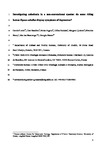Investigating anhedonia in a non-conventional species: Do some riding horses Equus caballus display symptoms of depression?
| dc.contributor.author | ESTEBAN , ARRIBAS REYES | |
| dc.contributor.author | Beaulieu, C | |
| dc.contributor.author | Argaud, S | |
| dc.contributor.author | Rochais, C | |
| dc.contributor.author | Quinton, M | |
| dc.contributor.author | Henry, S | |
| dc.contributor.author | Hausberger, M | |
| dc.contributor.author | Mason, G | |
| dc.date.accessioned | 2017-12-12T18:14:18Z | |
| dc.date.available | 2017-12-12T18:14:18Z | |
| dc.date.issued | 2015-01 | |
| dc.identifier.issn | 0168-1591 | |
| dc.identifier.issn | 1872-9045 | |
| dc.identifier.uri | http://hdl.handle.net/10026.1/10420 | |
| dc.description.abstract |
Investigating depression-like conditions in animals is methodologically challenging, but potentially important for welfare. Some riding horses display ‘withdrawn’ states of inactivity and low responsiveness that resemble the reduced engagement with the environment shown by certain depressed patients. To assess whether these animals are experiencing a depression-like state, we investigated anhedonia – the loss of pleasure, a key symptom of human depression – in 20 withdrawn and non-withdrawn horses from the same stable. The time horses spent being withdrawn appeared unrelated to age or sex, but correlated with time devoted to stereotypic behaviour, a possible marker of lifetime stress. Comparison with data collected 5 years earlier also revealed that horses scored as withdrawn then remained significantly likely to display the behaviour. We measured sucrose intake, a classic measure of anhedonia never previously applied to horses. Flavoured sugar blocks, novel to these subjects, were mounted in each stall and weighed 3, 8, 24 and 30 h after provision. We predicted that if affected by depression-like states, the most withdrawn horses would consume the least sucrose. This prediction was met (F1,18 = 4.65, two tailed p = 0.04). This pattern could, however, potentially reflect general appetite levels and/or food neophobia. To control for these confounds, hay consumption was measured over 5 days, as were subjects’ latencies to eat a meal scented with a novel odour. Although low hay consumption and long latencies to eat scented food did predict low sucrose consumption, statistically controlling for these confounds did not eliminate the relationship between being withdrawn and consuming less sucrose (although reducing it to a strong trend): F1,15 = 4.28, two-tailed p = 0.056. These data thus suggest long-lasting depression-like states in certain riding horses, which correlate with stereotypic behaviour and are characterised by anhedonia and bouts of ‘withdrawn’ unresponsiveness. | |
| dc.format.extent | 26-36 | |
| dc.language | en | |
| dc.language.iso | en | |
| dc.publisher | Elsevier BV | |
| dc.subject | Horses | |
| dc.subject | Depression | |
| dc.subject | Anhedonia | |
| dc.subject | Depression-like conditions | |
| dc.subject | Reduced engagement with environment | |
| dc.subject | DSM-V | |
| dc.title | Investigating anhedonia in a non-conventional species: Do some riding horses Equus caballus display symptoms of depression? | |
| dc.type | journal-article | |
| plymouth.author-url | https://www.webofscience.com/api/gateway?GWVersion=2&SrcApp=PARTNER_APP&SrcAuth=LinksAMR&KeyUT=WOS:000348625800004&DestLinkType=FullRecord&DestApp=ALL_WOS&UsrCustomerID=11bb513d99f797142bcfeffcc58ea008 | |
| plymouth.volume | 162 | |
| plymouth.publication-status | Published | |
| plymouth.journal | Applied Animal Behaviour Science | |
| dc.identifier.doi | 10.1016/j.applanim.2014.11.007 | |
| plymouth.organisational-group | /Plymouth | |
| plymouth.organisational-group | /Plymouth/Faculty of Science and Engineering | |
| plymouth.organisational-group | /Plymouth/REF 2021 Researchers by UoA | |
| plymouth.organisational-group | /Plymouth/REF 2021 Researchers by UoA/UoA04 Psychology, Psychiatry and Neuroscience | |
| dcterms.dateAccepted | 2014-11-09 | |
| dc.identifier.eissn | 1872-9045 | |
| dc.rights.embargoperiod | Not known | |
| rioxxterms.versionofrecord | 10.1016/j.applanim.2014.11.007 | |
| rioxxterms.licenseref.uri | http://www.rioxx.net/licenses/all-rights-reserved | |
| rioxxterms.type | Journal Article/Review |


